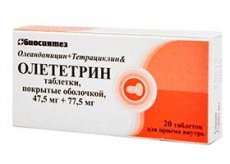Medical expert of the article
New publications
Preparations
Olethrin
Last reviewed: 03.07.2025

All iLive content is medically reviewed or fact checked to ensure as much factual accuracy as possible.
We have strict sourcing guidelines and only link to reputable media sites, academic research institutions and, whenever possible, medically peer reviewed studies. Note that the numbers in parentheses ([1], [2], etc.) are clickable links to these studies.
If you feel that any of our content is inaccurate, out-of-date, or otherwise questionable, please select it and press Ctrl + Enter.

Oletetrin is a systemic antibacterial drug. It belongs to the group of combined tetracyclines.
Indications Oletatrina
It is indicated for the elimination of infectious processes caused by pathogens sensitive to the drug:
- infections in the lower and upper respiratory tract, as well as ENT organs: tonsillitis with sinusitis, pharyngitis and laryngitis. In addition, tonsillitis, bronchitis, inflammation of the middle ear, pneumonia and bronchiectasis;
- infections of the urogynecological system: cystitis, gonorrhea with pyelonephritis, as well as prostatitis and endometritis;
- gastrointestinal infections: pancreatitis with cholecystitis;
- infectious pathologies: tularemia and meningitis, as well as rickettsiosis and brucellosis;
- osteomyelitis;
- erysipelas and infections in the area of soft tissues with skin.
Oletetrin can be used for the prevention or treatment of complications that develop after surgical interventions.
Release form
Available in capsules, 10 pieces inside 1 blister. One package contains 2 blister strips.
Pharmacodynamics
The medicine contains 2 antibiotics – oleandomycin and tetracycline. It has bacteriostatic properties.
Oleandomycin with tetracycline are antibiotics with a wide range of action. Their properties are due to the slowing down of the processes of binding microbial proteins at the ribosomal level (there is a destruction of the forming bonds between peptides, as well as the growth of polypeptide chains).
The medicine is effective against the following gram-positive microbes: streptococci and staphylococci, diphtheria corynebacterium and anthrax bacillus. It also acts against gram-negative microbes: gonococci, influenza bacillus, whooping cough bacillus, Brucella spp., legionella, enterobacter and klebsiella. In addition, it acts against anaerobes (clostridia) and other bacteria: mycoplasma, ureaplasma urealyticum, chlamydia, rickettsia and Spirochaetaceae.
Bacterial resistance to drugs develops much more slowly than in the case of separate use of oleandomycin and tetracycline.
Pharmacokinetics
The medicine is well absorbed from the gastrointestinal tract, after which it is distributed quite quickly within biological fluids and organs. It passes through the placental barrier and into mother's milk. It accumulates in the liver, teeth, as well as tumor tissues and the spleen.
Dosing and administration
Oletetrin should be taken in the amount of 250 mg (1 capsule) four times a day (dosages are calculated for adolescents over 12 years old and adults). The capsule should be taken before meals (half an hour before), without chewing. Wash down with water (150-200 ml).
You can take no more than 2000 mg of the medicine per day.
The duration of the therapeutic course depends on the severity of the pathology, as well as its course and drug effectiveness. On average, it is 5-10 days.
 [ 1 ]
[ 1 ]
Use Oletatrina during pregnancy
The medicine is prohibited for use in pregnant women.
Contraindications
Among the contraindications of the drug:
- hypersensitivity to tetracycline antibiotics or macrolide drugs, as well as any of the components of the drug;
- children under 12 years of age;
- severe forms of disorders in the functioning of the kidneys or liver;
- presence of leukopenia.
Side effects Oletatrina
The use of the drug can provoke the development of certain side effects:
- Gastrointestinal organs: development of diarrhea, anorexia, vomiting, dysphagia, abdominal pain, nausea, constipation and esophagitis with glossitis. Occasionally, liver dysfunction, transient increase in liver transaminase activity, as well as alkaline phosphatase, residual nitrogen and bilirubin levels may occur;
- allergic reactions: itching, skin rash, photosensitivity and Quincke's edema;
- nervous system organs: the appearance of headaches or dizziness;
- changes in laboratory test values: development of thrombocyto- or neutropenia, as well as hemolytic anemia and eosinophilia;
- reactions arising from chemotherapeutic procedures: development of intestinal dysbacteriosis, as well as candidiasis;
- Other: Children may experience darkening of tooth enamel. Vitamin B and K deficiencies may occur.
Overdose
Overdose may increase the side effects described above.
Therapy in this case should be symptomatic.
Interactions with other drugs
Medicines containing magnesium, calcium, aluminum and iron (such as iron supplements and antacids), as well as colestipol with cholestyramine reduce the absorption of Oletetrin. Therefore, when using them together, it is necessary to maintain intervals of 2 hours between doses.
The medicine cannot be combined with antibiotics that have bactericidal properties.
Combined use with retinol increases the likelihood of increased intracranial pressure.
Combination with anticoagulants may require adjustment of the dosage of antithrombotic drugs. When combined with hormonal contraceptives, their effectiveness is weakened, and the likelihood of uterine bleeding increases.
Storage conditions
The medicine should be kept in a place protected from moisture and sunlight, and inaccessible to small children. The temperature level is a maximum of 25°C.
 [ 4 ]
[ 4 ]
Shelf life
Oletetrin is permitted to be used for a period of 2 years from the date of manufacture of the medicine.
Attention!
To simplify the perception of information, this instruction for use of the drug "Olethrin" translated and presented in a special form on the basis of the official instructions for medical use of the drug. Before use read the annotation that came directly to medicines.
Description provided for informational purposes and is not a guide to self-healing. The need for this drug, the purpose of the treatment regimen, methods and dose of the drug is determined solely by the attending physician. Self-medication is dangerous for your health.

